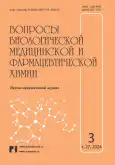Effect of ACTG(4-7)-PRO-GLY-PRO and ACTG(6-9)-PRO-GLY-PRO on the intensity of redox processes and behavioural status of rats under thyroid hyperfunction conditions
- Authors: Sergalieva M.U.1, Tsibizova A.A.1, Murtalieva V.K.1, Andreeva L.A.2, Myasoedov N.F.3, Samotrueva M.A.1
-
Affiliations:
- Astrakhan State Medical University of the Ministry of Health of Russia
- Institute of Molecular Genetics of the National Research Centre «Kurchatov Institute»
- Institute of Molecular Genetics, National Research Centre «Kurchatov Institute»
- Issue: Vol 27, No 3 (2024)
- Pages: 49-55
- Section: Problems of experimental biology and medicine
- URL: https://journals.eco-vector.com/1560-9596/article/view/629329
- DOI: https://doi.org/10.29296/25877313-2024-03-08
- ID: 629329
Cite item
Abstract
The aim of the work is to study the effect of melanocortins on the intensity of redox processes in the prefrontal region of the brain and the behavioral status of rats against the background of thyroid hyperfunction.
Material and methods. In the experiment, the test animals were divided into the following groups (n = 10): intact rats (control); animals treated with sodium salt pentahydrate L-thyroxine (hyperthyroidism); rats receiving ACTH (4-7)-Pro-Gly-Pro and individuals receiving ACTH (6-9)-Pro-Gly-Pro, respectively, intraperitoneally daily for 21 days, starting from day 22 of administration of sodium salt pentahydrate L-thyroxine. Hyperthyroidism was simulated in animals by intragastric administration of L-thyroxine sodium salt pentahydrate for 42 days. The intensity of lipoperoxidation processes was studied by the content of diene and triene conjugates in the prefrontal zone tissue, the initial level of TBА-reactive products, and the rates of spontaneous and ascorbic peroxidation of lipids. The level of protein peroxidation products was determined by the reaction of oxidized amino acid residues of proteins with 2,4-dinitrophenyl hydrazone. Evaluation of the enzymatic unit of the antioxidant system of the prefrontal region was carried out by determining the activity of superoxide dismutase and catalase. The behavioral status of laboratory rodents was studied using the «Hole board» test.
Results. The use of ACTH(4-7)-Pro-Gly-Pro and ACTH(6-9)-Pro-Gly-Pro compounds under experimental hyperthyroidism led to a decrease in the intensity of the processes of peroxidation of lipids, proteins and the restoration of levels of activity of antioxidant enzymes – superoxide dismutase and catalase in the tissue of the prefrontal region of the brain of animals, as well as correction behavioral indicators in the «Hole board» test.
Conclusion. The obtained experimental data indicate that ACTH(4-7)-Pro-Gly-Pro and ACTH(6-9)-Pro-Gly-Pro show antiperoxy and antioxidant activity against lipoperoxidation parameters and oxidative modification of proteins and enzymatic protection systems in the prefrontal brain zone tissue, as well as exert psychocorregating action on behavioral responses of white rats against the background of thyroid hyperfunction.
Full Text
About the authors
M. U. Sergalieva
Astrakhan State Medical University of the Ministry of Health of Russia
Author for correspondence.
Email: charlina_astr@mail.ru
Ph.D. (Biol.), Associate Professor of the Department of Pharmacognosy, Pharmaceutical Technology and Biotechnology
Russian Federation, AstrakhanA. A. Tsibizova
Astrakhan State Medical University of the Ministry of Health of Russia
Email: charlina_astr@mail.ru
Ph.D. (Pharm.), Associate Professor of the Department of Pharmacognosy, Pharmaceutical Technology and Biotechnology
Russian Federation, AstrakhanV. Kh. Murtalieva
Astrakhan State Medical University of the Ministry of Health of Russia
Email: charlina_astr@mail.ru
Assistant of the Department of Pharmacognosy, Pharmaceutical Technology and Biotechnology
Russian Federation, AstrakhanL. A. Andreeva
Institute of Molecular Genetics of the National Research Centre «Kurchatov Institute»
Email: charlina_astr@mail.ru
Deputy Head of the Laboratory of Molecular Pharmacology of Peptides, National Research Center
Russian Federation, MoscowN. F. Myasoedov
Institute of Molecular Genetics, National Research Centre «Kurchatov Institute»
Email: charlina_astr@mail.ru
Dr.Sc. (Chem.), Professor, Academician of the Russian Academy of Sciences
Russian Federation, MoscowM. A. Samotrueva
Astrakhan State Medical University of the Ministry of Health of Russia
Email: charlina_astr@mail.ru
Dr.Sc. (Med.), Professor, Head of the Department of Pharmacognosy, Pharmaceutical Technology and Biotechnology
Russian Federation, AstrakhanReferences
- Hernandez A. Cognitive function in hypothyroidism: what is that deiodinase again? Journal of Clinical Investigation. 2019; 129(1): 55–57. doi: 10.1172/JCI125203.
- Li L., Zhi M., Hou Z. et al. Abnormal brain functional connectivity leads to impaired mood and cognition in hyperthyroidism: A resting-state functional MRI study. Oncotarget. 2017; 8(4): 6283–6294. doi: 10.18632/oncotarget.14060.
- Villanueva I., Alva-Sánchez C., Pacheco-Rosado J. The role of thyroid hormones as inductors of oxidative stress and neurodegeneration. Oxid Med Cell Longev. 2013; 2013: 218145. doi: 10.1155/2013/218145.
- Флейшман М.Ю., Толстенок И.В., Иннокентьев А.А. Влияние пептида «Селанк» на уровень окислительного стресса в головном мозге и тонкой кишке белых крыс на модели черепно-мозговой травмы. Сибирский научный медицинский журнал. 2019; 39(2): 46–51. doi: 10.15372/SSMJ20190205 (Flejshman M.Ju., Tolstenok I.V., Innokent'ev A.A. Vlijanie peptida «Selank» na uroven' okislitel'nogo stressa v golovnom mozge i tonkoj kishke belyh krys na modeli cherepno-mozgovoj travmy. Sibirskij nauch-nyj medicinskij zhurnal. 2019; 39(2): 46–51. doi: 10.15372/SSMJ20190205).
- Vorvul A.O., Bobintsev I.I., Svishcheva M.V. et al. ACTH4-7-PGP peptide corrects behaviour and corticosterone level in rats under chronic stress. Russian Phy. J. named after I.M. Sechenov. 2021; 107(11): 1359–1371. doi: 10.31857/S0869813921110108.
- Борозденко Д.А., Ляхман Д.Н., Голубев Я.В. и др. Изучение фармакокинетики и нейропротекторной активности нового производного 4-фенилпирролидинона-2 в модели ишемического инсульта на животных. Вестник РГМУ. 2020; 1: 51–58. doi: 10.24075/vrgmu.2020.010 (Borozdenko D.A., Ljahman D.N., Golubev Ja.V. i dr. Izuchenie farmakokinetiki i nejroprotektornoj aktivnosti novogo proizvodnogo 4-fenilpirrolidinona-2 v modeli ishemicheskogo insul'ta na zhivotnyh. Vestnik RGMU. 2020; 1: 51–58. doi: 10.24075/vrgmu.2020.010).
- Chainy G.B., Sahoo D.K. Hormones and oxidative stress: an overview. Free Radical Research. 2020; 54(1): 1–26. doi: 10.1080/10715762.2019.1702656.
- Saklani P., Khan H., Gupta S. et al. Neuropeptides: Potential neuroprotective agents in ischemic injury. Life Sciences. 2022; 288: 120186. doi: 10.1016/j.lfs.2021.120186.
- Ben-Shushan S., Miller Y. Neuropeptides: Roles and activities as metal chelators in neurodegenerative diseases. The Journal of Physical Chemistry B. 2021; 125(11): 2796–2811. doi: 10.1021/acs.jpcb.0c11151.
- Dergunova L.V., Filippenkov I.B., Limborska S.A. et al. Pharmacotranscriptomics of peptide drugs with neuroprotective properties Med Res Rev. 2021; 41(2): 754–769. doi: 10.1002/med.21704.
- Vorvul A.O., Bobyntsev I.I., Medvedeva O.A. et al. Effects of His-Phe-Arg-Trp-Pro-Gly-Pro peptide on free-radical oxidation processes in conditions of chronic restraint stress. Bulletin of RSMU. 2021; (6): 61–66. doi: 10.24075/brsmu.2021.056.
Supplementary files









